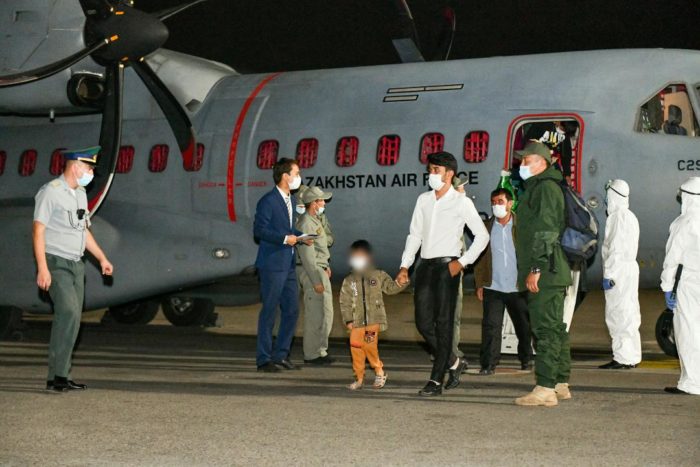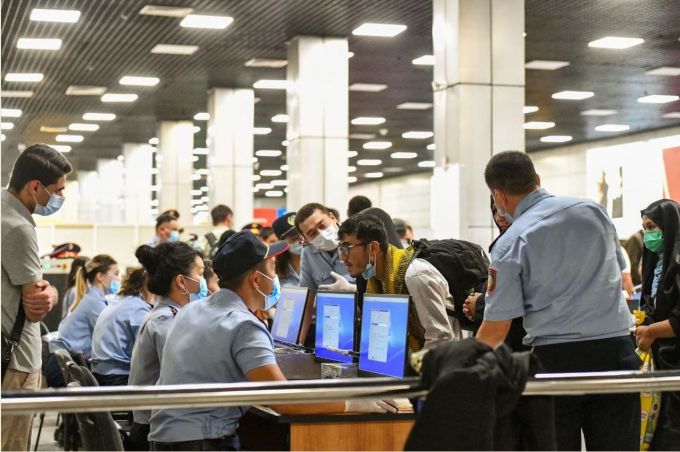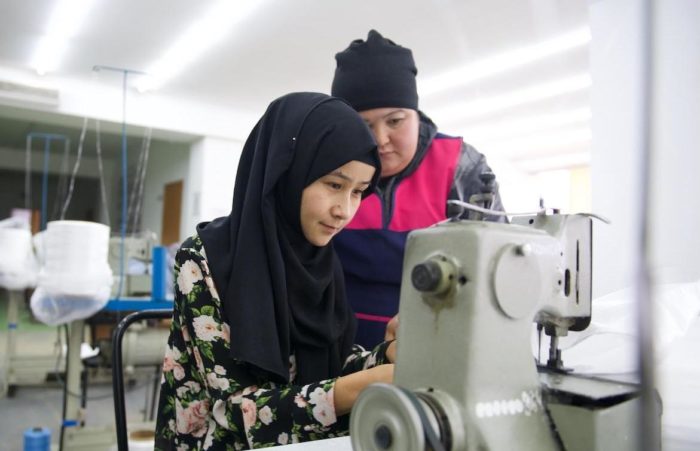Editor’s note: Since 1991, when Kazakhstan gained its independence, оver one million of ethnic Kazakhs have returned to their historical homeland, reports zakon.kz. In the analytical piece below translated from Russian this popular on-line news outlet details specific government policies that allowed Kazakh compatriots (kandas) to resettle comfortably in their country of origin.

Thirty-five ethnic Kazakhs returned to their homeland from Afghanistan on Sept.9 this year. Photo credit: MFA.
A month before Kazakhstan gained independence, the return of ethnic Kazakhs to their historical homeland began.
On Nov. 18, 1991, the Cabinet of Ministers of the Kazakh SSR adopted a resolution “On the procedure and conditions for the resettlement to Kazakh SSR of indigenous people who have expressed a desire to work in rural areas, from other republics and foreign countries.”
At that time, ethnic Kazakhs comprised only 40 percent of the population, that is, less than half in Kazakhstan. Due to this, an ethnic repatriation became a top priority. The repatriation happened in several stages.
The first stage lasted from 1991 to 2000. With the adoption of the above-mentioned resolution of the Cabinet of Ministers, the return and resettlement of Kazakh people to their historical and ethnic homeland began. This has become the first step in the implementation of the policy of immigration of ethnic Kazakhs.

Kazakh military officer is carrying a child during Jusan humanitarian operation in 2019. The operation was carried out by the Kazakh National Security Committee in collaboration with the Kazakh Ministry of Foreign Affairs, U.S. support and other international partners. Kazakhstan returned 12 Kazakh citizens, 4 men, 1 woman and 7 children caught up in the Syrian conflict to Kazakhstan. Photo credit: egemen.kz.
The next step focused on the organized resettlement of Kazakhs. The Supreme Council of Kazakhstan adopted on June 26, 1992 the Law “On Immigration,” according to which, the country began establishing the maximum number (quota) of ethnic immigrants and the financial resources necessary for their reception, settlement and adaptation.
Thus, for 1993, a quota was established in the number of 10,000 families, or approximately 40,000 people throughout the country, in fact 45,632 people arrived, but the number of families turned out to be less than expected – 9,441.

Photo credit: MFA.
With the subsequent growth of social and political reforms and the economic crisis, the established quota began to decrease. Its size decreased in 1999-2000 – to just 500 families. The situation required a solution, and for this purpose the State Program for Support of the Kazakh Diaspora was developed. On December 31, 1996 the President approved a decree, according to which Kazakhstan concluded bilateral agreements with Russia, Belarus, Ukraine with the expectation that this would facilitate the process of repatriation and solve the problems associated with the migration of the population and the determination of the citizenship of oralmans (a previous name for kandas – repatriated ethnic Kazakhs). Exactly three years later, the country signed multilateral agreements on a simplified procedure for the acquisition and termination of citizenship with Kyrgyzstan, Russia and Belarus.
In continuation of the policy to support repatriation, the President’s Address of 1997 put the demographic and migration policy as one of the leading priorities of national security. This was caused by a significant difference in the balance of migration – the number of citizens leaving for permanent residence in other countries at the time significantly exceeded the number of arrivals.

Recently the Voxpopuli.kz news website released a story about Kazakh ethnics who returned from Afghanistan. Majida,22, (on the photo) works as an intern at the workshop for the production of bags in Kokshetau. She plans to continue her studies at the University of Islamic Culture in Almaty after she gets all the necessary documents. Photo credit: Voxpopuli.kz.
To implement these guidelines, a new Law on Population Migration was adopted.
The law expanded the list of Kazakhs eligible for repatriation, which now included not only victims of Soviet repression, the so-called diaspora, but also all those who historically lived on territories bordering Kazakhstan before the country gained independence, the so-called autochthonous population.
The main principles of the repatriation policy were embodied in the “Concept of repatriation of ethnic Kazakhs to their historical homeland,” adopted by the government in 1998.
The main tasks in the repatriation of Kazakhs are the effective organization of resettlement process and their effective financing. In order to stimulate the return of oralmans to their homeland, the government of Kazakhstan, in 1999, began allocating social assistance to arriving compatriots, providing free housing and significant payments.
The country was experiencing an economic upturn, the standard of living had noticeably increased, which, in turn, played an important role in the increase in the number of oralmans who arrived.
The creation of the Agency for Migration and Demography, a central executive body outside the government, also contributed to the successful solution of ethnic migration issues. The agency functioned from 1997 to 2004; its key mission was the development and implementation of state demographic and migration policy that ensured population growth. This measure, coupled with the adoption of special programs and a well-built policy of ethnic migration, helped tilt the migration balance into a more positive dynamic.
Before 1995, the number of arrivals was less than the established quota, then from the late 1990s, its number began to grow, and this trend continued until 2010-2011.
In 2000, the Concept of the State Demographic Policy was adopted, which clearly outlined the priorities and main directions of the country’s demographic development, aimed at reducing migration losses. Kazakhstan signed interstate agreements with the countries that ethnic Kazakhs were leaving from, regarding a simplified procedure of renouncing their citizenships.
Thus, according to the Ministry of Labor and Social Protection of the Population, in 1991-2000, 42,387 families, or 183,652 people arrived in Kazakhstan, which amounted to more than 17 percent of the total number of the resettled.
In general, the first stage of repatriation can be characterized as the period of the formation of the legal framework. It began to bear fruit at the beginning of the 2000s. Before that, according to official data, there was a massive departure of the population, mainly from representatives of Slavic and German diaspora, whose ancestors were exiled to Kazakhstan under the Tsarist period, or deported during the Stalinist regime or sent as part of an effort to develop the virgin and fallow lands of Kazakhstan. During this time, the negative balance of migration not only completely absorbed the natural increase in the population of this period, but also exceeded it by more than two times.
Nevertheless, the same period of the country’s history demonstrated to the whole world that Kazakhstan has designated itself as an independent state, aimed at rectifying historical injustice and consolidating ethnic Kazakhs around their historical and ethnic homeland.
The second stage lasted from 2001 to 2011. In general, it is characterized by a stable increase in the number of repatriates, and hence a positive migration balance.
During the second stage, the regulatory and legal framework laid down at the previous stage gave impetus to an increase in the number of resettlements of ethnic Kazakhs to their historical and ethnic homeland. Several documents envisaged social assistance to oralmans, which included free travel to their permanent place of residence and transportation of property, allocation of funds for the purchase of housing in the amount of 100 Monthly Calculation Indexes per each family member, lump sum payments, the provision of food and more.
The Concept of Migration Policy was another key national document, which aimed at the improvement of the demographic situation in the country.
The Concept was also aimed at solving the problems of internal migration caused by the outflow of the population from rural settlements, the departure of people from small and medium-sized cities due to the closure of enterprises, as well as environmental reasons from the area of the Semipalatinsk test site and the Aral Sea region.
To implement the main directions of the Concept, the “Sectoral Program of Migration Policy of Kazakhstan for 2001-2010″ was developed. It provides for the improvement of the system of managing migration processes and legislation, including promoting the return of former compatriots to their homeland, as well as comprehensive support for their reintegration into the socio-economic and political life of the country.
As a result of the Concept’s implementation, an annual increase in the number of oralmans within the immigration quota was achieved. For comparison, if in 2001, 600 families arrived, then in 2007 there were 15,000. Over just those six years, the increase was 20-fold.
Positive migration balance and its subsequent increase were also achieved. Over the period of 2004-2008, the oralman immigration quota was entirely fulfilled – 41.4 percent of ethnic repatriates, or 439,400 people, arrived in the country over those years. The total number of arrivals over the years of independence comprised 1,062,200 ethnic Kazakhs.
The positive migration balance remained until the Nurly Kosh Program was suspended at the beginning of 2012. The preconditions for a reduction in the repatriation flow appeared back in 2006. Despite the fact that the “Sectoral Program of Migration Policy for 2001-2010” had not yet been completed, a new Concept of Migration Policy for 2007-2015 was adopted. Its goal was to reduce the negative consequences of migration flows as part of preservation and development of the national identity and security of the country. To achieve this, the reduction of illegal migration and the formation of a policy of selective migration was envisaged.
This resulted in the failure to fulfill the quota in 2009, one of the reasons for which was the government’s failure to fulfill its financial promises to the oralmans. The funds received were often insufficient for returning families to purchase housing.
The authors of the new Concept for 2007-2015 explained the need for its adoption by the fact that there were several problems in organizing the resettlement and integration of ethnic migrants into the new social conditions, such as:
– the uneven settlement of oralmans. As a consequence, secondary migration often occurred. Approximately 60 percent of migrants live in regions with a rather poor labor market – in the South Kazakhstan, Mangystau, Almaty and Zhambyl regions, which does not always correspond to the state policy of distributing labor resources;
– spontaneous movement of internal migrants. This creates social tension, exacerbates the imbalance in the internal labor market;
– unemployment of repatriates. One third of working age ethnic immigrants were not engaged in official labor activity, oralmans experienced difficulties in obtaining vocational education, placing children in preschool institutions.
Nevertheless, the measures taken by the state in the late 1990s, and especially the Concept of Migration Policy, have shown their effectiveness and efficiency. Thus, according to the Ministry of Labor and Social Protection of the Population, in 2001-2011, 697,769 ethnic Kazakhs arrived in Kazakhstan, which is more than 65 percent of the total number of ethnic Kazakhs who arrived during all the years of independence.
The third stage lasted from 2012 to 2020. Currently, Kazakhstan is implementing the Migration Policy for 2017-2021, which stresses that Kazakhstan must adhere to long-term permanent migration of ethnic repatriates. This includes creating conditions and incentives for national consolidation and the return of ethnic Kazakhs living abroad; stimulating their resettlement in regions in need of labor resources; and assisting in their adaptation and integration in Kazakhstan.
Stimulating repatriation was tied to the “Enbek” State Program for the Development of Productive Employment and Mass Entrepreneurship for 2017-2021. According to the program, persons included in the regional quota for oralmans receive subsidies for moving and payments to cover the cost of rent, housing and paying for utilities for the first year at the amount of 15 to 30 MCI per family.
On April 30, 2020, Minister of Labor and Social Protection Birzhan Nurymbetov said at a plenary meeting in the Senate that the Head of State ordered authorities to drop the term “oralman” for the more welcoming “kandas,” which means “fellow tribesman.”
According to Kazakh legislation, kandas migrants can enjoy certain benefits. Among them are:
– assistance in finding a job, improving qualifications and mastering a new profession;
– exemption from service in the ranks of the Armed Forces of Kazakhstan;
– allocation of a quota for admission to organizations of secondary vocational and higher vocational education;
– provision of places in schools, preschool organizations, as well as social protection institutions;
– payment of pensions and benefits;
– realisation of the rights of those victims of mass political repressions;
There are 14 centers for temporary accommodation of oralmans in the country. Since 2008, centers for adaptation and integration of oralmans have been operating in cities of Karagandy, Shymkent and the village of Aksukent, in the South Kazakhstan region.
Adaptation programs can provide legal advice, arrange for the studying of the state language (optionally, Russian as well), professional training, retraining and advanced training. Particular attention is paid to linguistic integration.
The government provides oralmans with medical care, education and social security. They belong to one of the target groups for which employment promotion measures are applied. More than 66 percent of oralmans of working age are employed in various spheres of production, every fourth is employed in agriculture.
To provide assistance to those returned to their homeland, councils of oralmans were created under the regional akimats, which study and solve problems encountered in new living conditions.
The Oralman information database has been created and is being improved. In the future, it will be integrated into a unified information system on the social situation in Kazakhstan. This will make it possible to promptly provide ethnic immigrants with a full range of social services.
There are several NGOs currently operating throughout the country that deal with the integration of oralmans.
According to the Ministry of Labor and Social Protection of the Population, in 2021 (data as of June 1) 6,935 people returned to their historical homeland and received the status of kandas.
Of these, the number of ethnic immigrants of working age is 56.5 percent, 24 percent are younger and 19.5 percent are pensioners. Of the working-age kandas people, 11.3 percent have a higher education, 39.5 percent have a specialized secondary education, 45.5 percent have a general secondary education, and 3.7 percent have no education at all.
More than half of the kandas (76.3 percent) are from Uzbekistan, 10.4 percent from China, 6.2 percent from Turkmenistan, 2.7 percent from Mongolia and 4.4 percent from other countries.
Arriving ethnic Kazakhs mainly live in Almaty (30.5 percent), Turkistan (15 percent), Mangystau (17.7 percent) and Zhambyl (8 percent) regions, as well as in Shymkent city (11 percent).
Since 1991, 1,077,300 ethnic Kazakhs have returned to their country.

